Incoming freshmen have been excluded from these previews, as we'd like to wait and see what they have to offer on the NCAA level before we come to any long-term conclusions.
-Top NBA Draft Prospects in the Big Ten, Part One
-(#1) Cody Zeller Video Scouting Report
-Top NBA Draft Prospects in the Big Ten, Part Two
(#2) Trey Burke
(#3) DeShaun Thomas
(#4) Aaron Craft
(#5) Branden Dawson
-Top NBA Draft Prospects in the Big Ten, Part Three
(#6) Trevor Mbakwe
(#7) Adreian Payne
(#8) Brandon Paul
(#9) Keith Appling
(#10) Christian Watford
-Top NBA Draft Prospects in the Big Ten, Part Four
(#11) Victor Oladipo
(#12) Rodney Williams
(#13) Tim Frazier
(#14) Drew Crawford
(#15) Will Sheehey
#16, Derrick Nix, 6'9, Senior, Center, Michigan State
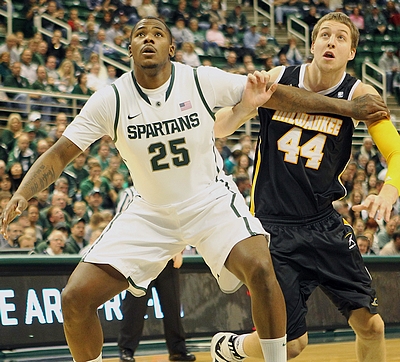
Matt Williams
Being called upon as the first big man off the bench for Michigan State last season after two years in a bit role, junior Derrick Nix had some nice moments as a regular in the middle of Tom Izzo's rotation. The bruising big man offered toughness in the paint and a wide-body defensively playing alongside do-everything senior Draymond Green. With Green out of the picture, Nix will be called upon to step up his game on the court and his leadership off it. Getting off to a rocky start this offseason, Nix was arrested for marijuana possession in early April, but has gone above and beyond his sentenced community service to atone for the incident. Regardless of his transgressions, the rising senior has a golden opportunity to showcase his talents this fall.
The first thing scouts will note when evaluating Nix this season will be his weight. Having shed more than a few pounds since tipping the scales near 320 as a freshman, Nix's conditioning, should not be the limiting factor on his senior year that it was early in his career. He has more room to improve his body and still lacks great explosiveness and speed, but has become noticeably more mobile as his weight has treaded closer to 260. Ultimately, the Michigan native's ability to stay on the floor and play at a high level in extensive minutes will be key to his and his team's success this season.
Nix's importance this season goes beyond being the only rising senior from last year's team. On the offensive end, Nix used just as many possessions per game in the post last season (4.1, half his possessions) as Draymond Green, seeing touches one-on-one on the block regularly when he was on the floor. Unless Adreian Payne shows significant progress on the offensive end, it seems likely that Nix will see his post usage expand significantly as one of the only Spartans well-equipped to battle in the paint offensively on a nightly basis, giving him a chance to build on the 8.1 points in 19 minutes per-game he averaged last season.
Based on what he's shown in his career to this point, Nix has a number of tools that should serve him well as his role expands. First and foremost, his physical strength allows him to establish deep position on the block and bully his way to the rim once he receives the ball. He also does a nice job moving the ball out of the post, showing good vision and a willingness to find the open man. His post repertoire may not be glamorous, and is rooted in his ability to get two feet in the paint and get the ball on the rim, but it is effective as he shot 56% from the field last season.
Nix's ability to become a more consistent post scorer will be significant because he has not shown the ability to score away from the rim at this point in his career. Despite how well he shot on the block last season, Nix struggled against longer defenders at times and took some wild shots off of counter-moves. If he can develop a comfort level with his left hand and be a bit more decisive, he has the opportunity to be ever more efficient with the additional touches he'll see this year.
Away from the rim, Nix attempted just three jump shots last season, shot 58% at the line, and only flashed the ability to put the ball on the floor and score in limited doses. If he can become a bigger threat from the midrange, he could have a veritable breakout year, as he already has shown the ability to finish at a high level.
Defensively, Nix can hold his own against virtually any low block scorer in the country. He has a wide body, a low center of gravity, and competes on every possession. He lacks great lateral speed, but he shows very good anticipation, will take contact right into the chest, and isn't afraid to step out on the perimeter to contest shots. If Nix can make a bigger impact on the glass, where he averaged a meager 4.6 defensive rebounds per-40 minutes pace adjusted last season, and show quicker feet defending dribble drives from the midrange, he could have a terrific year on this end of the floor.
Derrick Nix may not have written much of his NBA resume at this point, and certainly doesn't have prototypical size, athleticism, or rebounding ability for the center position at the next level, but the former top-100 recruit has some promising tools. If he can become a bigger factor on the glass on both ends, improve his offensive skill level, keep his weight down, and take advantage of his opportunity to shine this year, he could emerge as one of the top seniors in the Big Ten this season, and a bona fide NBA prospect.
#17, Tim Hardaway Jr, 6-6, Junior, SG/SF, Michigan
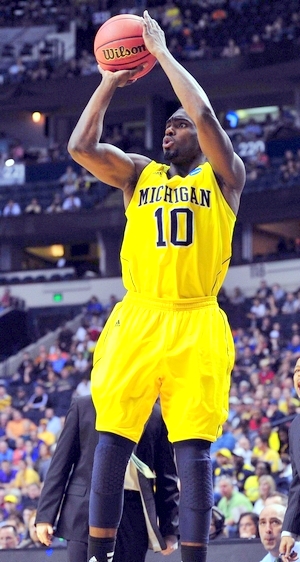
Joe Treutlein
After an impressive freshman season in which he significantly exceeded expectations, Tim Hardaway Jr was unable to take the next step in his development as a sophomore. Hardaway improved his shooting percentages inside the arc (48.3 to 53.5%), but regressed with his outside shooting (36.7% to 28.3%), otherwise posting an extremely similar stat line as compared to his freshman year.
Similar to his statistical output, Hardaway also looks like the same player from a skills perspective, though his drop in scoring efficiency from three-point range was the most noticeable and most concerning development in his sophomore campaign. After shooting a solid 36.7% as a freshman (buoyed by the high percentage of shots he takes off the dribble), Hardaway fell to a disappointing 28.3% as a sophomore, not entirely unsurprising given his inconsistent mechanics and style of play.
Hardaway continues to have the strange distinction of being a more efficient shooter off the dribble than spotting up, as he hits for a superb 1.012 points per shot on pull-ups as opposed to a below average 0.816 points per shot on catch-and-shoot jumpers. Improving his spot-up jumper is still the most important thing he can do to improve his game, as we pointed out the last time we profiled him.
While Hardaway clearly possesses strong shot-making ability and shows flashes of being a deadly shooter inside and outside the arc, he struggles to consistently display the same mechanics, though it's certainly something he can improve on. Hardaway establishes a much better rhythm shooting the ball when he's coming off the dribble and stepping into his shot, doing a better job to keep his body upright and his feet underneath him. He doesn't exhibit the same balance or get his lower body into the shot when he's spotting up, and trying to translate that aspect of his off-the-dribble shot to his catch-and-shoot shot is likely the key to becoming a more consistent and versatile shooter.
In terms of attacking the basket, Hardaway still does a good job creating separation and getting to the basket with the ball, but his ability to finish when contested by weak side defenders remains a sore point. While he shows good touch and the ability to finish difficult shots in the lane at times, he doesn't do a good job finishing through contact and seems to suffer from a still lanky build that hasn't yet reached its full potential.
Hardaway's ability to create separation for pull-up jumpers from the mid-range is his most useful offensive weapon at this stage, and he does a good job doing so out of both isolations and pick-and-rolls. Hardaway also made some slight strides this season with his passing game, increasing his pace adjusted per 40 minute assists from 2.3 to 2.7 per game and showing a good feel for making simple drive-and-dishes after penetrating into the lane and drawing the defense.
On the defensive end, the story was the same for Hardaway as a sophomore, as he has all the tools to be a very good defender at the shooting guard position, and even is at times, but he still needs to improve his consistency and play at a high level on every possession. He looks strong matching up in isolation, showing a good stance and lateral quickness, and even made some improvements fighting through screens on pick-and-rolls, but is prone to lagging off his man off the ball at times and not always putting in full effort on every play.
Looking forward, Hardaway clearly brings an intriguing package of tools to the table with his athletic tools, shot-making abilities, and defensive potential, but he needs to become more consistent in all aspects of his game. Hardaway has a lot of room to improve with his three-point shooting, and would benefit himself greatly not only return to, but also exceed his freshman shooting numbers from behind the arc this year. It would be a big boon to both his draft stock and to open up the rest of his offensive game, and will likely be critical to his chances at finding a long-term niche in the NBA down the road.
#18, Jared Berggren, 6-10, Senior, Power Forward, Wisconsin
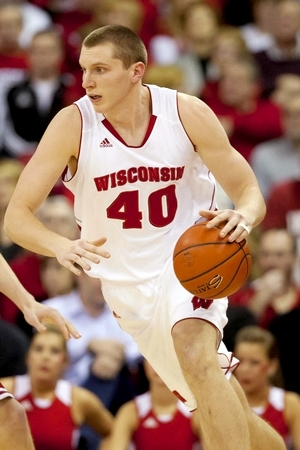
Jonathan Givony
After redshirting his freshman season and seeing just 277 total minutes of action over the following two years, few could have anticipated Jared Berggren developing into one of the most effective big men in the Big Ten. That's exactly what he was for Wisconsin, though, leading the conference in blocks per-minute, while shooting 37% from beyond the arc. Now going into his senior year, Bo Ryan will need Berggren to continue to make strides, as the team moves forward without their floor general and leading scorer from last season, Jordan Taylor.
From a physical standpoint, Berggren doesn't really jump off the page on first glance. While he has a solid wingspan, he possesses a frail frame which may struggle to carry too much additional weight, and isn't very fluid or graceful with his movements. He doesn't run the floor particularly well, and won't wow NBA scouts seeing him for the first time with his quickness or explosiveness either.
Berggren's role in Wisconsin's offense was fairly simple last year, seeing most of his time at center. He received a decent amount of looks in the post with his back to the basket, where he has the footwork, craftiness and touch to score against many of the weaker or less experienced big men he'll match up with at times in the Big Ten. Against bulkier post players he doesn't always find the same success, as he lacks the strength to establish great position and finish through contact at times, one of the reasons he's doesn't get to the free throw line at a great rate.
Berggren also spends a good amount of time on the perimeter, where is a confident shooter who doesn't hesitate to fire away when open from mid-range or beyond the arc. He possesses unconventional shooting mechanics, but shoots it the same every time and thus sees good results, to the tune of 37.2% last season on 3.4 three-point attempts per game. He can also put ball on the floor a little in a straight line and make his way to the rim, showing a solid skill-level for a collegiate big man in the process.
The anchor of one of the top five defensive teams in college basketball according to Ken Pomeroy, Berggren doesn't look like a defensive stalwart on first glance, but certainly backs that up when watching him on film.
Switching out onto smaller players on the perimeter regularly defending the pick and roll, Berggren doesn't have too much of a problem moving his feet and staying in front of quicker ball-handlers. He's fairly agile recovering after getting beat, and uses his long wingspan really well to contest and reject shots around the rim. His timing and footwork is excellent, and he is capable of sending shots back with either hand, helping explain why he led the Big Ten in this category in front of players like Meyers Leonard, Cody Zeller, Jared Sullinger and others.
Inside the post, Berggren isn't quite as effective, as he struggles giving up deep position inside the paint to bulkier big men, who can get him in foul trouble. Considering his lanky frame, burgeoning jump-shot and increasing proficiency guarding the perimeter, it appears that his future at the pro level lies at the power forward position, rather than at center. It will be interesting to see if he's able to get more playing time there next season, something that will likely depend on the continued development of fellow Wisconsin big men Frank Kaminsky and Evan Anderson.
Berggren's biggest issue as far as the NBA is concerned is the fact that he's a very poor rebounder on both ends of the floor, ranking amongst the worst big men in the NCAA in this category last season in fact, even when adjusting for the snail's pace Wisconsin plays at (second slowest in the NCAA). Getting stronger and doing a better job of boxing out his opponent could help here, but it's possible that with his frail frame and average leaping ability he may never be dominant in this area. Nevertheless, NBA teams will want to see him doing a better job cleaning up the glass in his senior year.
Berggren did a good job emerging as a prospect to watch last season, and now has a chance to take another step towards solidifying his professional future with a strong senior year.
#19, Devyn Marble, 6'6, Shooting Guard, Junior, Iowa
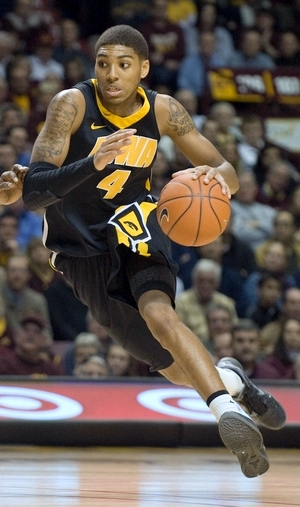
Kyle Nelson
After an unspectacular freshman season, Devyn Marble emerged from his father's equally troubled and legendary shadow as Iowa's second leading scorer during his sophomore season while wearing a variety of positional hats. Furthermore, though he wasn't known as a prolific scorer, he finished the season with a 31 point performance (7/8 3FG) in a loss to Oregon in the second round of the NIT. Following reports of a productive summer, expectations are high that Marble may follow his father footsteps as both a centerpiece of Iowa's offense and as an NBA prospect.
Standing 6'6, Marble possesses solid size for an NBA wing, but must continue to add bulk to his skinny 194-pound frame. Getting stronger is especially important because he's a smooth, rather than explosive athlete, deceptively quick with the ball in his hands, but not one to dominate defenders in transition or around the basket.
His size and decent overall physical profile are especially interesting when taking his offensive skill set into consideration. Marble is not a prolific scorer at this point in his career, as he only averages 11.5 points per game and 15.2 points per 40 minutes pace adjusted, but he improved in nearly every statistical category as a sophomore while embracing a variety of roles from being Iowa's starting point guard to the team's best shot creator. His versatility is exemplified by Synergy's Play Type Breakdown, in which Marble finds 20% of his offensive possessions in transition, 16% while spotting up, 16% in isolation sets, and 13% operating out of the pick-and-roll.
On paper, it would seem as though Marble's best asset is his much-improved perimeter shooting, as he made 39.3% of his attempts last season. A look behind the numbers, however, reveals that Marble finished the season absolutely on fire from beyond the arc, taking and making more shots than ever before in his career. Even during his hot streak he hardly looked the part of a knockdown shooter, though, lacking a consistent and quick release in which his right elbow has a tendency to fly out mid-release. Looking forward, he must continue to shoot as a junior like he did down the stretch last year.
Elsewhere, Marble has proven himself to be a solid scorer, especially from mid-range where he shows a variety of moves off the dribble to create space for open looks. He also does a good job of splitting defenders and getting into the lane, though he is just an average finisher overall. His 44.5% 2-point conversion rate reflects his struggles finishing efficiently around the basket, likely due to his average explosiveness and strength. Getting stronger would certainly improve matters, but so too would continuing to work on his ball-handling ability, particularly developing more advanced moves, and getting more comfortable finishing with both hands.
It's worth pointing out that while Marble is likely not a point guard at this or the next level, he was the second best passing wing in our database last season, averaging 4.8 assists per 40 minutes pace adjusted and his 2.07 assist/turnover ratio stacks up well even amongst point guard prospects. For a wing, he has an excellent basketball IQ, exemplified in his court vision and excellent instincts with the ball in his hands. He makes the right pass without hesitation, makes crisp entry passes, and can even run the pick-and-roll at times. He is a willing passer and an unselfish teammate, which will only make him a more attractive prospect if he improves as a scorer.
For all of his talent offensively, Marble doesn't stand out on defense. He doesn't show the desire to consistently stay in front of his man, but his length allows him to both remain a factor on the perimeter even after he is beaten and to grab 2.0 steals per 40 minutes pace adjusted. While he is not a particularly assertive player in general, his lack of aggressiveness can be particularly glaring on defense, especially when he lets his man finish inside or fails to contest perimeter shots. One is left with the impression that he could partially overcome his lack of strength to be an above average NCAA defender with increased effort and intensity.
Looking forward toward his junior season, Marble has established himself as a player to watch in the Big Ten. Scouts will be watching to see if he can become a more aggressive scorer while continuing to make strides with his jump shooting and defense. While he did a good job of revealing himself to be more than just Roy Marble's son, for better or for worse, he has the opportunity as a junior to distinguish himself further by taking full advantage of his expanding role in Iowa's offense to lead the Hawkeye's back to respectability after a long period of rebuilding.
#20, Aaron White, 6'8, Sophomore, Power Forward, Iowa
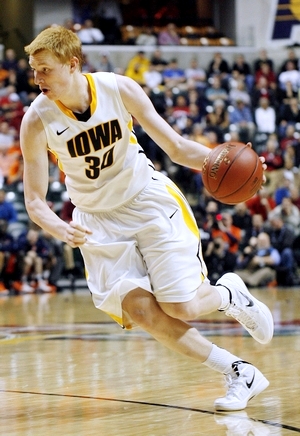
Derek Bodner
Not a highly touted recruit out of high school, Aaron White made the most of his freshman year at Iowa. White was named to the Big Ten All-Freshman team as he helped the Hawkeyes bounce back from 10 and 11 win seasons the previous two years to post an 18-17 season and make a short run in the NIT.
White started off the season fairly slow, averaging 7.4 points per game over his first 10 games. His conditioning looked to improve as the season went on and his play picked up accordingly, culminating in an NIT run where he averaged 23.5 points per game and 9.5 rebounds per game in 33 minutes.
White measures in at 6'8", which is undersized for a player who at this stage looks to project almost exclusively as a power forward. Showing a frame that should fill out in time, along with long arms, and intriguing fluidity and agility, White has some solid tools to work with from a physical standpoint. He runs the floor well and is able to finish with authority on the move, even though it looks like he would be well served to add some lower body strength to help him make better use of his talent on both ends of the floor.
White gets a good portion of his offense from hustle plays. He shows a consistently outstanding effort level on both ends of the court and gets rewarded by way of transition baskets, offensive rebounds, and cuts to the basket. White is relatively fast in transition and has good hands, making him a solid target to fill a lane on the fast break. He's a very active offensive rebounder, and is able to gather control of the ball quickly, wasting little time and chance for defenders to gather themselves.
White shows potential as a jump shooter, and his form out to 15-17 feet looks solid and consistent. It begins to break down the further away from the basket he gets, and he has had some trouble extending that out to collegiate three point range, shooting just 27.9% on the season from beyond the arc. Since nearly 75% of his jump shots have come from three point range according to Synergy Sports Technology, that has overall left him fairly inefficient as a jump shooter, but the potential is there if he is able to extend his range out a few more feet.
White looks comfortable putting the ball on the floor, particularly with his left hand. He has neither the first step nor the advanced ball handling moves to create much offense for himself in the half-court, but if his perimeter jump shot becomes more reliable he is able to put one or two dribbles together to make a defender pay for an over-aggressive close out.
As a finisher around the rim, White has solid touch and is good in open spaces, but at times struggles to finish through contact or over taller defenders. He also struggles to establish deep post position, and doesn't look all that comfortable on the block when he gets there. He does have a right handed hook that he uses successfully on occasion but would need to add some lower body strength to establish position to post-up with regularity, even at the collegiate level. With that said, he has a quick second bounce and is regularly able to play above the rim in the open court, so there is plenty of hope that he can continue to improve his scoring ability in the half-court as he continues to develop.
On the defensive side of the ball, White has some hurdles to overcome if he wants to see court time in the NBA. His overall technique looks solid and the effort is there, but he doesn't move his feet very well laterally and as such will struggle to defend face-up 4's against the pick and roll. His lack of lower body strength is once again readily evident when defending post-up players, and the combination of allowing deep position and not having the size to alter shots is a major concern when projecting him to the next level.
Aaron White exceeded expectations last year and has put himself on the map of NBA executives with his strong freshman season. If he can extend his range, and continue to improve his frame and overall skill-level, White can increase his role in the Hawkeyes offensive scheme and garner more consideration from decision makers at the next level. Right now he looks like a sure bet to develop into one of the more productive big men in the Big Ten conference in the next year or two, but it will take some more time to learn just how big his upside is long term.













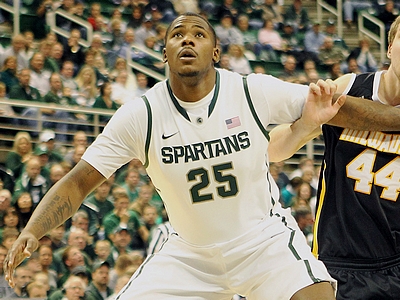



























Comments